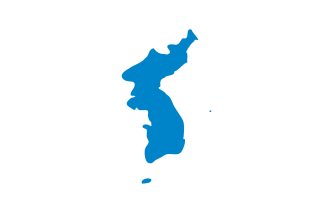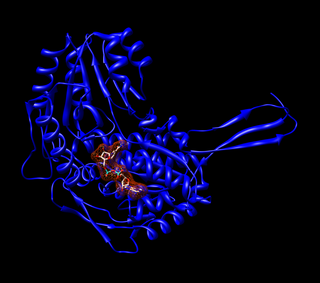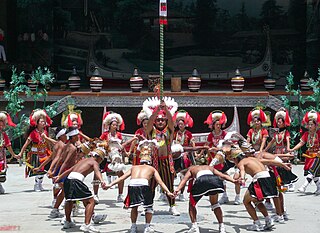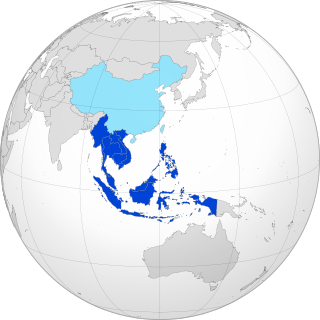Related Research Articles

Asia is the largest continent in the world by both land area and population. It covers an area of more than 44 million square kilometers, about 30% of Earth's total land area and 8% of Earth's total surface area. The continent, which has long been home to the majority of the human population, was the site of many of the first civilizations. Its 4.7 billion people constitute roughly 60% of the world's population.

Korea is a peninsular region in East Asia. Since 1945, it has been divided at or near the 38th parallel, now known as the Korean Demilitarized Zone. In 1948, two states declared independence, both claiming sovereignty over all of Korea: South Korea comprising its southern half and North Korea comprising its northern half. The region consists of the Korean Peninsula, Jeju Island, and minor islands near the peninsula. The peninsula is bordered by China to the north and Russia to the northeast, across the Amnok and Duman rivers. It is separated from Japan to the southeast by the Korea Strait.

Koreans are an East Asian ethnic group native to Korea. The majority of Koreans live in the two Korean nation states of North and South Korea, which are collectively referred to as Korea. As of 2021, an estimated 7.3 million ethnic Koreans resided outside of Korea. Koreans are also an officially recognised ethnic minority in other several Continental and East Asian countries, including China, Japan, Kazakhstan, Russia, and Uzbekistan. Outside of Continental and East Asia, sizeable Korean communities have formed in Germany, the United Kingdom, France, the United States, Canada, Australia, and New Zealand.

The Yamato people or the Wajin is a term to describe the ethnic group that comprises over 98% of the population of Japan. Genetic and anthropometric studies have shown that the Yamato are an admixture of the migratory Kofun and Yayoi, who arrived from mainland East and Southeast Asia via the Korean Peninsula, as well as the indigenous Jōmon that were already living on the Japanese archipelago for thousands of years prior.
Pax Sinica is a historiographical term referring to periods of peace and stability in East Asia, Northeast Asia, Southeast Asia, and Central Asia led by China. A study on the Sinocentric world system reveals that the multiple periods of Pax Sinica, when taken together, amounted to a length of approximately two thousand years.

The Utsuls are a Chamic-speaking East Asian ethnic group which lives on the island of Hainan and are considered one of the People's Republic of China's unrecognized ethnic groups. They are found on the southernmost tip of Hainan near the city of Sanya.

Alcohol flush reaction is a condition in which a person develops flushes or blotches associated with erythema on the face, neck, shoulders, ears, and in some cases, the entire body after consuming alcoholic beverages. The reaction is the result of an accumulation of acetaldehyde, a metabolic byproduct of the catabolic metabolism of alcohol, and is caused by an aldehyde dehydrogenase 2 deficiency.

The culture of Asia encompasses the collective and diverse customs and traditions of art, architecture, music, literature, lifestyle, philosophy, food, politics and religion that have been practiced and maintained by the numerous ethnic groups of the continent of Asia since prehistory. Identification of a specific culture of Asia or universal elements among the colossal diversity that has emanated from multiple cultural spheres and three of the four ancient River valley civilizations is complicated. However, the continent is commonly divided into six geographic sub-regions, that are characterized by perceivable commonalities, like culture, religion, language and relative ethnic homogeneity. These regions are Central Asia, East Asia, North Asia, South Asia, Southeast Asia and West Asia.

Alcohol tolerance refers to the bodily responses to the functional effects of ethanol in alcoholic beverages. This includes direct tolerance, speed of recovery from insobriety and resistance to the development of alcohol use disorder.

The Sinosphere, also known as the Chinese cultural sphere, East Asian cultural sphere, or the Sinic world, encompasses multiple countries in East Asia and Southeast Asia that historically were heavily influenced by Chinese culture, norms and traditions. According to academic consensus, the Sinosphere comprises Greater China, Japan, Korea, and Vietnam. Other definitions may include the regions of modern-day Mongolia and Singapore, largely due to limited historical Chinese influences or increasing modern-day Chinese diaspora. The Sinosphere is not to be confused with Sinophone, which indicates countries where a Chinese-speaking population is dominant.

Aldehyde dehydrogenases are a group of enzymes that catalyse the oxidation of aldehydes. They convert aldehydes to carboxylic acids. The oxygen comes from a water molecule. To date, nineteen ALDH genes have been identified within the human genome. These genes participate in a wide variety of biological processes including the detoxification of exogenously and endogenously generated aldehydes.
Haplogroup D1 or D-M174 is a subclade of haplogroup D-CTS3946. This male haplogroup is found primarily in East Asia, Magar-ethnic Nepal and the Andaman Islands. It is also found regularly with lower frequency in Central Asia and Mainland Southeast Asia, and, more rarely, in Europe and the Middle East.

The Austronesian peoples, sometimes referred to as Austronesian-speaking peoples, are a large group of peoples in Taiwan, Maritime Southeast Asia, parts of Mainland Southeast Asia, Micronesia, coastal New Guinea, Island Melanesia, Polynesia, and Madagascar that speak Austronesian languages. They also include indigenous ethnic minorities in Vietnam, Cambodia, Myanmar, Thailand, Hainan, the Comoros, and the Torres Strait Islands. The nations and territories predominantly populated by Austronesian-speaking peoples are sometimes known collectively as Austronesia.

Aldehyde dehydrogenase, mitochondrial is an enzyme that in humans is encoded by the ALDH2 gene located on chromosome 12. ALDH2 belongs to the aldehyde dehydrogenase family of enzymes. Aldehyde dehydrogenase is the second enzyme of the major oxidative pathway of alcohol metabolism. ALDH2 has a low Km for acetaldehyde, and is localized in mitochondrial matrix. The other liver isozyme, ALDH1, localizes to the cytosol.

In the course of the peopling of the World by Homo sapiens, East Asia was reached about 50,000 years ago. The "recent African origin" lineage of 70 kya diverged into identifiable East Eurasian and West Eurasian lineages by about 50 kya. This early East Asian lineage diverged further during the Last Glacial Maximum, contributing outgoing from Mainland Southeast Asia significantly to the peopling of the Americas via Beringia about 25 kya. After the last ice age China became cut off from neighboring island groups. The previous phenotypes of early East Asians became either replaced or prevailed among more geographically distant groups.

East Asia is a region of Asia, which is defined in both geographical and ethno-cultural terms. The modern states of East Asia include China, Japan, Mongolia, North and South Korea, and Taiwan. Hong Kong and Macau, two coastal cities located in the south of China, are autonomous regions under Chinese sovereignty. The economies of Japan, South Korea, China, Taiwan, Hong Kong, and Macau are some of the world's largest and most prosperous economies. East Asia borders Siberia and the Russian Far East to the north, Southeast Asia to the south, South Asia to the southwest, and Central Asia to the west. To the east is the Pacific Ocean and to the southeast is Micronesia.

The ancestral population of modern Asian people has its origins in the two primary prehistoric settlement centres – greater Southwest Asia and from the Mongolian plateau towards Northern China.

The Bamboo network or the Chinese Commonwealth is a term used to conceptualize connections between businesses operated by the Overseas Chinese community in Southeast Asia. The Overseas Chinese business networks constitute the single most dominant private business groups outside of East Asia. It links the Overseas Chinese business community of Southeast Asia, namely Malaysia, Indonesia, Singapore, Thailand, Vietnam, the Philippines, and Myanmar with the economies of Greater China. The Overseas Chinese play a pivotal role in Southeast Asia's business sector as they dominate Southeast Asia's economy today and form the economic elite across all the major Southeast Asian countries. The Chinese have been an economically powerful and prosperous minority for centuries and today exert a powerful economic influence throughout the region. Overseas Chinese wield tremendous economic clout over their indigenous Southeast Asian majority counterparts and play a critical role in maintaining the regions aggregate economic vitality and prosperity. Since the turn of the 21st century, postcolonial Southeast Asia has now become an important pillar of the Overseas Chinese economy as the bamboo network represents an important symbol of adumbrating itself as an extended international economic outpost of Greater China.

Alcohol intolerance is due to a genetic polymorphism of the aldehyde dehydrogenase enzyme, which is responsible for the metabolism of acetaldehyde. This polymorphism is most often reported in patients of East Asian descent. Alcohol intolerance may also be an associated side effect of certain drugs such as disulfiram, metronidazole, or nilutamide. Skin flushing and nasal congestion are the most common symptoms of intolerance after alcohol ingestion. It may also be characterized as intolerance causing hangover symptoms similar to the "disulfiram-like reaction" of aldehyde dehydrogenase deficiency or chronic fatigue syndrome. Severe pain after drinking alcohol may indicate a more serious underlying condition.
This article summarizes the genetic makeup and population history of East Asian peoples and their connection to genetically related populations, as well as Oceanians and partly, Central Asians and South Asians, which are collectively referred to as "East Eurasians" in population genomics.
References
- ↑ "Introducing East Asian Peoples" (PDF). International Mission Board. September 10, 2016. Archived (PDF) from the original on May 13, 2018. Retrieved June 11, 2018.;
Minahan, James B. (2014). Ethnic Groups of North, East, and Central Asia: An Encyclopedia. ABC-CLIO. pp. xx. ISBN 978-1610690171.;
"How Asians view each other". The Economist. September 18, 2015. Archived from the original on January 19, 2018. Retrieved January 18, 2018.;
Khoo, Isabelle (May 30, 2017). "The Difference Between East Asians And South Asians Is Pretty Simple". Huffington Post. Archived from the original on January 12, 2018. Retrieved January 11, 2018.;
Silberman, Neil (1996). The Oxford Companion to Archaeology, Volume 1. Oxford University Press (published December 5, 1996). p. 151. ISBN 978-0195076189.;
Lim, SK (2011-11-01). Asia Civilizations: Ancient to 1800 AD. ASIAPAC. p. 56. ISBN 978-9812295941. - ↑ "East Asia Countries Total Population". Archived from the original on 2019-04-09. Retrieved 2020-06-03.
- ↑ "Large East Asian Diaspora figures" (PDF). Archived (PDF) from the original on 2014-03-23. Retrieved 2020-06-03.
- ↑ Pan and Pfeil (2004), "Problems with Terminology", pp. xvii–xx.
- ↑ Prescott, Anne (2015). East Asia in the World: An Introduction. Routledge. p. 6. ISBN 978-0765643223.
- ↑ Prescott, Anne (2015). East Asia in the World: An Introduction. Routledge. p. 3. ISBN 978-0765643223.
- ↑ Ikeo, Aiko (1996). Economic Development in Twentieth-Century East Asia: The International Context. Routledge. p. 1. ISBN 978-0415149006.
- ↑ Yoshimatsu, H. (2014). Comparing Institution-Building in East Asia: Power Politics, Governance, and Critical Junctures. Palgrave Macmillan. p. 1. ISBN 978-1137370549.
- ↑ Kim, Mikyoung (2015). Routledge Handbook of Memory and Reconciliation in East Asia. Routledge. ISBN 978-0415835138.
- ↑ Hazen, Dan; Spohrer, James H. (2005). Building Area Studies Collections. Otto Harrassowitz (published 2005-12-31). p. 130. ISBN 978-3447055123.
- ↑ Siska, Veronika; Jones, Eppie Ruth; Jeon, Sungwon; Bhak, Youngjune; Kim, Hak-Min; Cho, Yun Sung; Kim, Hyunho; Lee, Kyusang; Veselovskaya, Elizaveta; Balueva, Tatiana; Gallego-Llorente, Marcos; Hofreiter, Michael; Bradley, Daniel G.; Eriksson, Anders; Pinhasi, Ron; Bhak, Jong; Manica, Andrea (2017). "Genome-wide data from two early Neolithic East Asian individuals dating to 7700 years ago". Science Advances . 3 (2) (published February 1, 2017): e1601877. Bibcode:2017SciA....3E1877S. doi:10.1126/sciadv.1601877. PMC 5287702 . PMID 28164156.;
Wang, Yuchen; Lu Dongsheng; Chung Yeun-Jun; Xu Shuhua (2018). "Genetic structure, divergence and admixture of Han Chinese, Japanese and Korean populations". Hereditas. 155. SpringerLink: 19. doi: 10.1186/s41065-018-0057-5 . PMC 5889524 . PMID 29636655.;
Wang, Yuchen; Lu, Dongsheng; Chung, Yeun-Jun; Xu, Shuhua (April 6, 2018). "Genetic structure, divergence and admixture of Han Chinese, Japanese and Korean populations". Hereditas. 155. SpringerLink: 19. doi: 10.1186/s41065-018-0057-5 . PMC 5889524 . PMID 29636655.;
"Introducing East Asian Peoples" (PDF). International Mission Board. September 10, 2016. Archived (PDF) from the original on May 13, 2018. Retrieved June 11, 2018.;
Sloan, Kathleen; Krimsky, Sheldon (2011). Race and the Genetic Revolution: Science, Myth, and Culture. Columbia University Press. p. 156. ISBN 978-0231156967.;
Herreria, Carla (May 17, 2017). "Basically Nobody Knows Who Counts As An Asian Person". The Huffington Post. Archived from the original on May 9, 2018. Retrieved June 11, 2018.;
Lin, Yu-Cheng; Wang, Mao-Jiun J.; Wang, Eric M. (June 23, 2003) [2003]. "The comparisons of anthropometric characteristics among four peoples in East Asia". Department of Industrial Engineering and Engineering Management. Applied Ergonomics. 35 (2). Elsevier Ltd.: 173–8. doi: 10.1016/j.apergo.2004.01.004 . PMID 15105079. S2CID 6640984.;
Machery, Edouard; O'Neill, Elizabeth (2014). Current Controversies in Experimental Philosophy (Current Controversies in Philosophy). Routledge (published February 28, 2014). p. 6. ISBN 978-0415519670.;
Ludwig, Theodore M. (2003). Spiritual Care in Nursing Practice. LWW. pp. 165. ISBN 978-0781740968.;
Shaules, Joseph (2007). Deep Culture: The Hidden Challenges of Global Living . Multilingual Matters. pp. 43. ISBN 978-1847690173.;
Kowner, Rotem; Demel, Walter (2014). Race and Racism in Modern East Asia: Western and Eastern Constructions (1st ed.). Brill Academic Publishing. p. 41. ISBN 978-9004285507.;
Leach, Mark M. (2006). Cultural Diversity and Suicide: Ethnic, Religious, Gender, and Sexual Orientation Perspectives. Routledge. p. 127. ISBN 978-0789030184.;
Leibo, Steve (2016). East and Southeast Asia 2016-2017. Rowman & Littlefield. p. 1. ISBN 978-1475829068.;
Steinberg, Shirley R.; Kehler, Michael; Cornish, Lindsay (June 17, 2010). Boy Culture: An Encyclopedia, Volume 1. Greenwood. p. 58. ISBN 978-0313350801.;
Salkind, Neil J. (2008). Encyclopedia of Educational Psychology . Sage Publications. pp. 56. ISBN 978-1412916882.;
Minahan, James B. (2014). Ethnic Groups of North, East, and Central Asia: An Encyclopedia. ABC-CLIO. pp. xx–xxvi. ISBN 978-1610690171.;
Stodolska, Monika (2013). Race, Ethnicity, and Leisure: Perspectives on Research, Theory, and Practice. Human Kinetics. p. 229. ISBN 978-0736094528.;
Lim, SK (2011-11-01). Asia Civilizations: Ancient to 1800 AD. ASIAPAC. p. 56. ISBN 978-9812295941. - ↑ Vickers, Edward (2010). History Education and National Identity in East Asia. Routledge (published October 21, 2010). p. 125. ISBN 978-0415948081.
- ↑ Demel, Walter; Kowner, Rotem (2015). Race and Racism in Modern East Asia: Interactions, Nationalism, Gender and Lineage. Brill (published April 23, 2015). p. 255. ISBN 978-9004292925.
- ↑ Shimabukuro, Moriyo. (2007). The Accentual History of the Japanese and Ryukyuan Languages: a Reconstruction, p. 1.
- ↑ Miyake, Marc Hideo. (2008). Old Japanese: a Phonetic Reconstruction. p. 66. at Google Books
- ↑ Kim, Chin-Wu (1974). The Making of the Korean Language. Center for Korean Studies, University of Hawai'i.
- ↑ Miller, David (2007). Modern East Asia: An Introductory History. Routledge (published December 15, 2007). pp. 7–8. ISBN 978-0765618221.
- 1 2 Walker, Hugh Dyson (2012). East Asia: A New History. AuthorHouse. p. 2.
- ↑ Hayes, Louis D (2009). Political Systems of East Asia: China, Korea, and Japan. Greenlight. pp. xi. ISBN 978-0765617866.
- ↑ Hazen, Dan; Spohrer, James H. (2005). Building Area Studies Collections. Otto Harrassowitz (published December 31, 2005). p. 1. ISBN 978-3447055123.
- ↑ Richter, Frank-Jurgen (2002). Redesigning Asian Business: In the Aftermath of Crisis. Quorum Books. p. 15. ISBN 978-1567205251.
- ↑ Kang, David C. (2012). East Asia Before the West: Five Centuries of Trade and Tribute. Columbia University Press. pp. 33–34. ISBN 978-0231153195.
- 1 2 Lewis, Mark Edward (2012). China's Cosmopolitan Empire: The Tang Dynasty. Belknap Press (published April 9, 2012). p. 156. ISBN 978-0674064010.
- 1 2 Edwin O. Reischauer, "The Sinic World in Perspective," Foreign Affairs 52.2 (January 1974): 341—348. JSTOR Archived 2017-01-15 at the Wayback Machine
- 1 2 3 Lim, SK (2011-11-01). Asia Civilizations: Ancient to 1800 AD. ASIAPAC. p. 89. ISBN 978-9812295941.
- 1 2 3 Goscha, Christopher (2016). The Penguin History of Modern Vietnam: A History. Allen Lane. ISBN 978-1846143106.
- ↑ "How was Hangul invented?". The Economist. 2013-10-08. Archived from the original on 28 March 2018. Retrieved 5 May 2018.
- ↑ Yang, Melinda A. (2022-01-06). "A genetic history of migration, diversification, and admixture in Asia". Human Population Genetics and Genomics. 2 (1): 1–32. doi: 10.47248/hpgg2202010001 . ISSN 2770-5005.
...In contrast, mainland East and Southeast Asians and other Pacific islanders (e.g., Austronesian speakers) are closely related to each other [9,15,16] and here denoted as belonging to an East and Southeast Asian (ESEA) lineage (Box 2). …the ESEA lineage differentiated into at least three distinct ancestries: Tianyuan ancestry which can be found 40,000-33,000 years ago in northern East Asia, ancestry found today across present-day populations of East Asia, Southeast Asia, and Siberia, but whose origins are unknown, and Hòabìnhian ancestry found 8,000-4,000 years ago in Southeast Asia, but whose origins in the Upper Paleolithic are unknown.
- ↑ Lee H, Kim SS, You KS, Park W, Yang JH, Kim M, Hayman LL (2014). "Asian flushing: genetic and sociocultural factors of alcoholism among East asians". Gastroenterology Nursing. 37 (5): 327–36. doi:10.1097/SGA.0000000000000062. PMID 25271825. S2CID 206059192.
- ↑ Brooks PJ, Enoch MA, Goldman D, Li TK, Yokoyama A (March 2009). "The alcohol flushing response: an unrecognized risk factor for esophageal cancer from alcohol consumption". PLOS Medicine. 6 (3): e50. doi: 10.1371/journal.pmed.1000050 . PMC 2659709 . PMID 19320537.
- ↑ J. Yoo, Grace; Odar, Alan Y. (2014). Handbook of Asian American Health. Springer (published April 23, 2015). p. 132. ISBN 978-1493913442.
- 1 2 Peng Y, Shi H, Qi XB, Xiao CJ, Zhong H, Ma RL, Su B (January 2010). "The ADH1B Arg47His polymorphism in east Asian populations and expansion of rice domestication in history". BMC Evolutionary Biology. 10: 15. doi: 10.1186/1471-2148-10-15 . PMC 2823730 . PMID 20089146.
- ↑ Eng MY, Luczak SE, Wall TL (2007). "ALDH2, ADH1B, and ADH1C genotypes in Asians: a literature review". Alcohol Research & Health. 30 (1): 22–7. PMC 3860439 . PMID 17718397.
- ↑ "Rs671". Archived from the original on 2021-04-27. Retrieved 2020-02-07.
